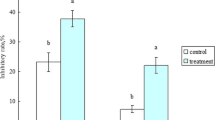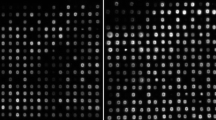Abstract
The allelopathy-competition separation (ACS) based approach was used to explore the biointerference relationship between rice accessions and barnyardgrass exposed to different nitrogen (N) supplies in hydroponics. Rice accession PI312777 exhibited high allelopathic potential to suppress the growth of accompanying weeds, especially when the culture solution had low N content. The non-allelopathic rice Lemont showed an opposite result. Additionally, subtractive hybridization suppression (SSH) was used to construct a forward SSH-cDNA library of PI312777 to investigate gene expression profiles under low N treatment. A total of 35 positive clones from the SSH-cDNA library were sequenced and annotated. According to the function category, 24 genes were classified into five groups related to primary metabolism, phenolic allelochemical synthesis, plant growth/cell cycle regulation, stress response/signal transduction, and protein synthesis/degradation. Among them, two up-regulated genes that encode PAL and cytochrome P450 were selected. Their transcript abundance at low N level was compared further between the allelopathic rice and its counterpart by utilizing real-time quantitative polymerase chain reaction (qRT-PCR). The transcription levels of the two genes increased in both rice accessions when exposed to low N supply, but PI312777 at a higher magnitude than Lemont. At 1, 3, and 7 days of the treatments, the corresponding relative expression levels of PAL were 11.38, 4.83, and 3.57 fold higher in PI312777 root, but there were 1.15, 2.74, and 2.94 fold increases for Lemont, compared with the control plants fed with regular nutrient. The same trend was found for cytochrome P450. These findings suggest that the stronger ability of PI312777 to suppress target weeds, especially in low N nutrient conditions, might be attributed to the stronger activation of the genes that function in de novo synthesis of allelochemicals.



Similar content being viewed by others
References
An, M., Liu, D. L., Johnson, I. R., and Lovett, J. V. 2003. Mathematical modelling of allelopathy: II. The dynamics of allelochemicals from living plants in the environment. Ecol. Model 161:53–66.
Anterola, A. M., Jeon, J. H., Davin, L. B., and Lewis, N. G. 2002. Transcriptional control of monolignol biosynthesis in Pinus taeda: factors affecting monolignol ratios and carbon allocation in phenylpropanoid metabolism. J. Biol. Chem 277:18272–18280.
Bauwe, H., and Kolukisaoglu, U. 2003. Genetic manipulation of glycine decarboxylation. J. Exp. Bot 54:1523–1535.
Belz, R. G. 2007. Allelopathy in crop/weed interactions – an update. Pest Manag. Sci 63:308–326.
Belz, R. G., and Hurle, K. 2004. A novel laboratory screening bioassay for crop seedling allelopathy. J. Chem. Ecol 30:175–198.
Bi, H. H., Zeng, R. S., Su, L. M., An, M., and Luo, S. M. 2007. Rice allelopathy induced by methyl jasmonate and methyl salicylate. J. Chem. Ecol 35:1089–1103.
Bryant, J. P., Chapin, F. S. III, Reichardt, P. B., and Clausen, T. P. 1987. Response of winter chemical defense in Alaska paper birch and green alder to manipulation of plant carbon/nutrient balance. Oecologia 72:510–514.
Chishake, N., and Horiguchi, T. 1997. Responses of secondary metabolism in plants to nutrient defiency. Soil Plant Nutr 43:987–991.
Diatchenko, L., Lau, Y. F. C., Campbell, A. P., Chenchik, A., Moqadam, F., Huang, B., Lukyanov, S., Lukyanov, K., Gurskaya, N., Sverslov, E. D., and Siebert, P. D. 1996. Suppression subtractive hybridization: A method for generating differentially regulated or tissue-specific cDNA probes and libraries. Proc. Natl. Acad. Sci. USA 93:6025–6030.
Dixon, R. A., and Paiva, N. L. 1995. Stress-induced phenylpropanoid metabolism. Plant Cell 7:1085–1097.
Dixon, R. A., Achnine, L., Kota, P., Liu, C. J., Reddy, M. S. S., and Wang, L. J. 2002. The phenylpropanoid pathway and plant defense-a genomics perspective. Mol. Plant Pathol 3:371–390.
Einhellig, F. A. 1999. An integrated view of allelochemicals amid multiple stress, pp. 479–494, in Ingerjit, K. M. M. Dakshini, and C. L. Foy (eds.). Principles and practices of plant ecology: Allelochemical InteractionsCRC Press LLC, Boca Raton, FL.
Elias, M., Potock, M., Cvrokova, F., and Zarsky, V. 2002. Molecular diversity of phospholipase D in angiosperms. BMC Genomics 3:1471–2164.
Fajer, E. D., Bowers, M. D., and Bazzaz, F. A. 1992. The effect of nutrients and enriched CO2 environments on production of carbon-based allelochemicals in plantago: A test of the carbon/nutrient balance. Am. Nat 140:702–723.
Friebe, A. 2006. Brassinosteroids in induced resistance and induction of tolerance to abiotic stress in plants, pp. 233–242, in A. M. Rimando, and S. O. Duke (eds.). Natural Products for Pest ManagementAmerican Chemical Society, Washington, DCACS Symposium Series No. 927.
Fritz, C., Palacios-Rojas, N., Feil, R., and Stitt, M. 2006. Regulation of secondary metabolism by the carbon–nitrogen status in tobacco: nitrate inhibits large sectors of phenylpropanoid metabolism. Plant J 46:533–548.
He, H. Q., Shen, L. H., Xiong, J., Jia, X. L., Lin, W. X., and Wu, H. 2004. Conditional genetic effect of Allelopathy in rice (Oryza sativa L.) under different environmental conditions. Plant Growth Regul 44:211–218.
Kasai, T., Inoue, M., Koshiba, S., Yabuki, T., Aoki, M., Nunokawa, E., Seki, E., Matsuda, T., Matsuda, N., Tomo, Y., Shirouzu, M., Terada, T., Obayashi, N., Hamana, H., Shinya, N., Tatsuguchi, A., Yasuda, S., Yoshida, M., Hirota, H., Matsuo, Y., Tani, K., Suzuki, H., Arakawa, T., Carninci, P., Kawai, J., Hayashizaki, Y., Kigawa, T., and Yokoyama, S. 2004. Solution structure of a BolA-like protein from Mus musculus. Protein Sci 13:545–548.
Kim, K. U., Shin, D. H., Lee, I. J., and Kim, H. Y. 2000. Rice Allelopathy in Korea, pp. 57–82, in K.U. Kim, and D.H. Shin (eds.). Rice AllelopathyChan-Suk Park Publish, Korea.
Kim, S. Y., Madrid, A. V., Park, S. T., Yang, S. J., and Olofsdotter, M. 2005. Evaluation of rice allelopathy in hydroponics. Weed Res 45:74–79.
Kovacik, J., Klejdus, B., Backor, M., and Repca, M. 2007. Phenylalanine ammonia-lyase activity and phenolic compounds accumulation in nitrogen-deficient Matricaria chamomilla leaf rosettes. Plant Sci 172:393–399.
Li, L., Popko, J. L., Zhang, X. H., Osakabe, K., Tsai, C. J., Joshi, C. P., and Chiang, V. 1997. A novel mutifuctional O-methyltransferase implicated in a dual methylation pathway associated with lignin biosynthesis in loblolly pine. Proc. Natl. Acad. Sci. USA 94:5461–5466.
Liu, J. S., Xie, J., Yang, W. D., and Li, L. X. 2006. Allelopathic effect of alexandrium tamarense on prorocentrum donghaiense under limited nutrient conditions. J. Trop. Subt. Bota 14:207–212(in Chinese).
Luo, Q., Michaelis, C., and Weeks, G. 1994. Overexpression of a truncated cyclin B gene arrests Dictyostelium cell division during mitosis. J. Cell Sci 107:3105–3114.
Macias, F. A., Molinillo, J. M. G., Varela, R. M., and Galindo, J. C. G. 2007. Allelopathy - a natural alternative for weed control. Pest Manag. Sci 63:327–348.
Mihaliak, C. A., Gershenzon, J., and Croteau, R. 1991. Lack of rapid monoterpene turnover in rooted plants: implication of theories of plant defense. Oecologia 87:373–376.
Olofsdotter, M. 1998. Allelopathy in rice, pp. 1–5, in M. Olofsdotter (ed.). Allelopathy in RiceInternational Rice Research Institute, Manila, Philippines.
Olofsdotter, M., Jensen, L. B., Pamplona, R., Navarez, D., Lee, S. B., and Pheng, S. 2002. Towards utilization of allelopathy-the rice example, pp. 197–207, in M. J. Reigosa, and N. Pedrol (eds.). Allelopathy-from molecules to ecosystemsScience Publishers Inc. Enfield (NH), USA.
Pfaffl, M. W. 2001. A new mathematical model for relative quantification in real-time RT-PCR. Nuc. Acids Res 29:2002–2007.
Razal, R. A., Ellis, S., Singh, S., Lewist, N. G., and Towers, G. H. N. 1996. Nitrogen recycling in phenylpropanoid metabolism. Phtochemistry 41:31–35.
Reichardt, P. B., Chapin, P. S., Bryant, J. P., Matter, B. R., and Clausen, T. P. 1991. Carbon/nutrient balance as a predictor of plant defense in Alaska balsam poplar: potential importance of metabolite turnover. Oecologia 88:401–406.
Scheible, W. R., Morcuende, R., Czechowski, T., Fritz, C., Osuna, D., Palacios-Rojas, N., Schindelasch, D., Thimm, O., Udvardi, M. K., and Stitt, M. 2004. Genome-wide reprogramming of primary and secondary metabolism, protein synthesis, cellular growth processes, and the regulatory infrastructure of Arabidopsis in response to nitrogen. Plant Physiol 136:2483–2499.
Shen, L. H., and Lin, W. X. 2007. Effects of phosphorus levels on allelopathic potential of rice co-cultured with barnyardgrass. Allelopathy J 19:393–402.
Sheveleva, E., Chmara, W., Bohnert, H. J., and Jensen, R. G. 1997. Increased salt and drought tolerance by D-ononitol production in transgenic Nicotiana tabacum L. Plant Physiol 115:1211–1219.
Wu, H. W., Pratley, J., Lemerle, D., and An, M. 1999. Crop cultivars with allelopathy capability. Weed Res 39:171–180.
Wysocka-Diller, J. W., Helariutta, Y., Fukaki, H., Malamy, J. E., and Benfey, P. N. 2000. Molecular analysis of SCARECROW function reveals a radial patterning mechanism common to root and shoot. Development 127:595–603.
Xiong, J., Lin, W. X., Zhou, J. J., Wu, M. H., Chen, X. X., and He, H. Q. 2005. Studies on biointerference between barnyardgrass and rice accessions at different nitrogen regimes, pp. 501–504, in J. D. I. Harper, M. An, H. Wu, and J. H. Kent (eds.). Proceedings Fourth World Congress on AllelopathyCharles Sturt University, Wagga Wagga, NSW, Australia.
Xu, M., Hillwig, M. L., Prisic, S., Coates, R. M., and Peters, R. J. 2004. Functional identification of rice syn-copalyl diphosphate synthase and its role in initiating biosynthesis of diterpenoid phytoalexin/allelopathic natural products. Plant J 39:309–318.
Xu, Y., and Hall, T. C. 1993. Cytosolic triosephosphate isomerase is a single gene in rice. Plant Physiol 101:683–687.
Yamagata, H., Kunimastu, K., Kamasuka, H., Kuramota, T., and Iwaski, T. 1998. Rice bifunctional a-amylase/subitilisin inhibitor: characterization, localization and changes in developmental and germinating seeds. Biosci. Biotech. Biochem 62:978–985.
Acknowledgements
This work was supported by the National Natural Science Foundation of China (No. 30471028, 30070068,30200170, 30671220) and Provincial Natural Science Foundation of Fujian, China (No. 20020F012, K04038). The Authors thank Dr H. Wu and An Min, who are working as scientists in plant allelopathy, at Charles Sturt University, Wagga Wagga, NSW 2678, AUSTRALIA, for their critical reading of the manuscript.
Author information
Authors and Affiliations
Corresponding author
Rights and permissions
About this article
Cite this article
Song, B., Xiong, J., Fang, C. et al. Allelopathic Enhancement and Differential Gene Expression in Rice under Low Nitrogen Treatment. J Chem Ecol 34, 688–695 (2008). https://doi.org/10.1007/s10886-008-9455-x
Received:
Revised:
Accepted:
Published:
Issue Date:
DOI: https://doi.org/10.1007/s10886-008-9455-x




